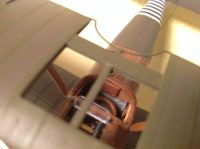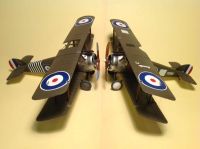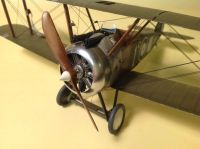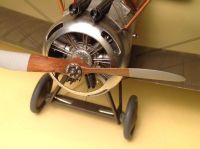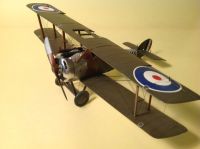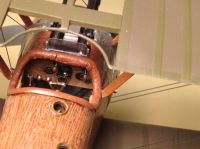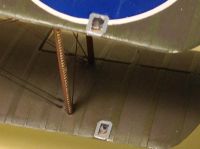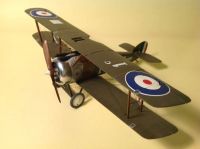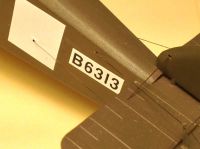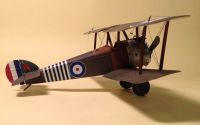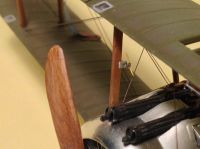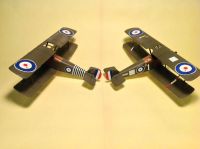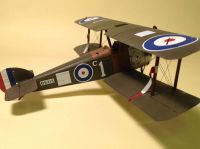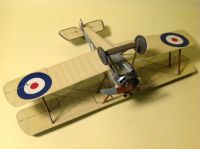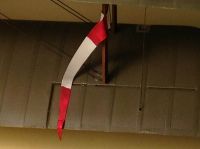Hobbycraft 1/32 Sopwith Camel - William Barker's B6313
By Russell Bucy
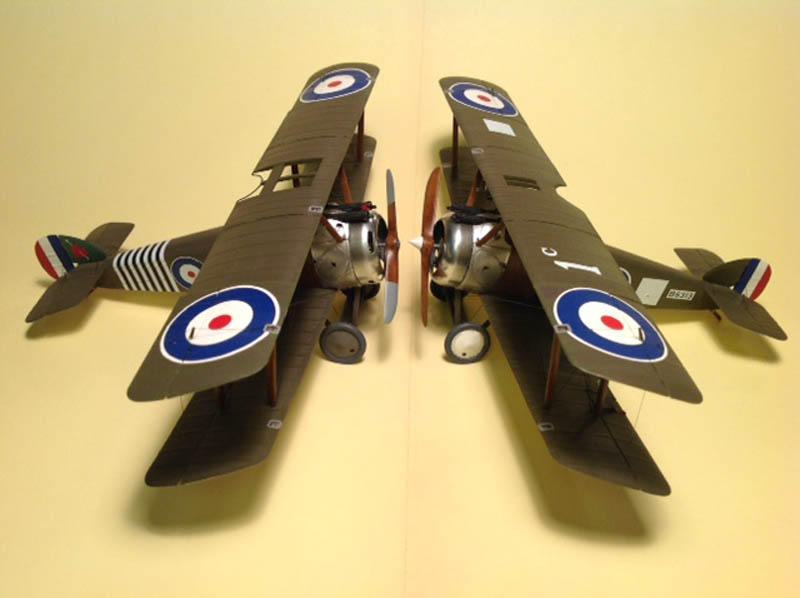
A Tale of "Two" Camels - William Barker's B6313
B6313 in late 1918. Note the victory "notches" painted on the left interplane strut, the upper wing cut-out, and the four cooling vents in the cowl. Barely visible in this photo is the "little red devil" mounted in the right hand Vickers gun:
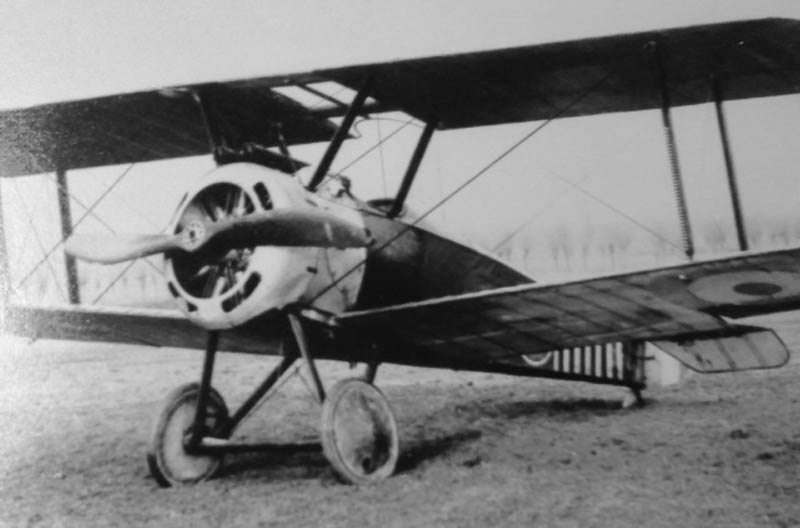
Introduction
Canadian Ace William Barker flew Sopwith Camel B6313 from September 1917 until October 1918. During that time it was repainted in at least five different marking schemes. After more than a year of combat flying, it had also been significantly modified from the original to a more "souped up" version of the Camel to Major Barker's personal taste. I've chosen to create two models of B6313 to reflect the very first and the very last renditions of this famous aircraft.
History
Sopwith Camel B6313 was flown to France in September 1918 by Canadian William Barker when he joined 28 Squadron RFC. Squadron markings consisted of a white square applied to the right upper wing and on both sides of the fuselage, and white wheel covers. In addition, the individual aircraft number and assigned flight markings were marked on the upper wing and fuselage. In Barker's case, B6313 was the first aircraft in "C" flight, designated by a large "1" with a small "c". Cowlings and forward fuselages were left in bare metal, while the area on the sides and behind the cockpit were left in clear varnished wood. B6313 also sported a small white painted "Cone d'Penetration" on the propeller hub. As a Flight leader, Barker would also have had red and white command pennants on the rear interplane struts. In November 1917, 28 Squadron was transferred to the Italian theater, where the markings for the aircraft and flight number were changed to a large "N" on the upper wing and fuselage sides replacing the aircraft and flight numbers, but the white square was retained.
Barker was again transferred to command 66 Squadron, RFC in April 1918, and B6313 went with him, even though 66 Squadron was equipped with the Bristol F2B. His new Squadron markings consisted of a black cowl and forward fuselage, and a band of four white and three black stripes forward of the tail empennage. Squadron aircraft also had black tails with a red heart pierced by an arrow leaning towards the rear, and the propeller "Cone d'Penetration" was repainted red. Later, B6313 would return to a polished bare metal cowling and forward fuselage, but the white/black fuselage band increased in length, and it's tail was re-painted in medium green with a forward leaning pierced heart motif. Sometime during his tenure in Italy, Barker "acquired" the radiator cap decoration from an Italian automobile in the form of a "little red devil". He mounted this "mascot" as a sighting device over his right hand gun. Barker also had the upper wing fabric over the cockpit area removed to increase visibility, and had four large equidistant holes cut into the cowl for improved cooling of his Clerget engine, making B6313 look very distinct from other Camels. British pilots were discouraged from marking their aircraft with "victory tallies", however, Barker kept a score of white "notches" painted on his left forwarded and outboard interplane strut which eventually totaled 49 confirmed "notches" by the time he left Italy.
In October 1917, Barker was transferred back to the Western Front and France where he received a new Sopwith Snipe, which he painted to resemble his beloved B6313, with black and white stripes on the fuselage forward of the tail empennage, and mounting his "little red devil" over the right machine gun. B6313 had ingloriously been relegated to an RFC disposal depot in Italy, but Barker managed to "liberate" the chronometer and the red devil before leaving it. In October 1918, Barker became famous for single-handedly engaging an estimated 60 German aircraft, and managed to shoot down four more to bring his total number of "notches" to 53 recorded victories before he crash landed his Snipe while badly wounded. For this action he was awarded the Victoria Cross, Britains highest honor. Despite this high honor, a few weeks later he received a bill from the Air Ministry for B6313's "liberated" chronometer!
The Kit
This is HobbyCraft's "Camel Aces" Clerget engined offering. This kit should not be confused with earlier HobbyCraft and Academy offerings, that had poorly detailed forward fuselages and unrealistic "valley and peak" wing ribbing, a condition the Academy kit still suffers from today. The HobbyCraft molds were originally cast by Academy, and a lawsuit ensued between the two companies in the UK and Canada for this and other "pirated" HobbyCraft molds. Fortunately for us, the result was that HobbyCraft improved the molds with this "Camel Aces" newer kit to compete with the Academy boxings. Many modelers still confuse the two kits, and HobbyCraft's "Camel Aces" boxings often receive an unjustified "bad rap" for the earlier kits shortcomings. Although still sparse in the cockpit area, the forward fuselage, wings, cowling, and others details have been totally revised and are quite nice. The wing is scale thickness and has prototypical rib tapes, fine aileron attachment points, and the cowling and fuselage panels have been revised to add fine detail and access ports, whereas the older kit still has the "trenches and lumps" in that area. The pan on the lower fuselage behind the engine has also been revised on the newer kit to reflect its correct rounded shape instead of the triangular shape of the old kit. All in all, the Camel Aces boxing is a nice kit.
Modifications
Even though there are nice features in the newer kit, I undertook some scratchbuilding to improve the model:
- cockpits were scratchbuilt using basswood strips, fine wire, copper and brass wire and tubing, and the fuel tanks were constructed out of aluminum from Coke cans. The dash was made from stripwood, and Mike Grandt instruments with brass tubing cut to size for the instrument bezels. Tom's Model Work's British WWI aircraft PE sets provided wicker seats and throttle details. A fuel primer pump was constructed from soldered brass tube and rod. Cockpit comings and the seat arm rests were made from real leather scrounged from "goody" bags given to first class passengers on United Air Lines (these were nice leather bags, but the outside leather skin could be peeled away for modeling purposes). Milliput was used to form seat cushions, and belts were provided from Eduard's PE WWI British belt sets. Not much of this detail is visible due to the position of the lower wing, but I know it's in there!
- The Vickers gun cooling jackets were drilled out to accept hypodermic needle barrels, Tom's Model Work's provided the charging handles, and Evergreen styrene feed and ejection chutes were constructed. The carburetor intakes were made from aluminum tubing.
- Engines were detailed with styrene plugs, fine wire for ignition wiring, and push rods were added from Micro Engineering steel wire. The rotary engine and props were mounted on "telescoping" brass tube and rod shafts. The landing gear was modified with aluminum tubing and brass rod to give a typical Camel "splayed" sit, a look which happened when the Camel was fully loaded. The landing gear "bungees" were simulated with heavy thread painted gray.
- For the late version of B6313, the upper wing decking was removed in the area of the two viewing "windows" all the way to the trailing edge of the wing. An Evergreen styrene rear spar and rib support was fashioned, and a piece of brass wire was formed to take the place of the wing trailing edge and cockpit entry cut-out. The early version of B6313 has two command pennants made from aluminum foil appropriately painted and attached to the rear interplane struts.
- The "Cone de' Penetration" for the early B6313 came from the kit (a nice touch in the newer kit), as did the "little red devil" mascot, which was provided in a decal. I attached the "devil" decal to a clear piece of acetate and carefully cut around it. A set of photo etch in the new Wingnut Wings Camel replicates this in their kit. Maybe someday they'll market their PE sets separately and I'll replace mine. Scratchbuilt generators were made from styrene with prop blades from Tom's Model Work's.
- Rigging was accomplished with my favorite brown "Chameleon" brand 4lb fishing leader and Eduard anchors and turnbuckles where appropriate. The crossed rigging through a bullet shaped retainer over the guns is distinctive in the Camel. This was done by turning a styrene rod on my variable speed Dremel tool. I then cut it to size and drilled a tiny hole through it to thread the rigging through. Windscreens were constructed using acetate from grocery store bakery containers and Evergreen styrene strip stock.
- The PC10 paint was mixed from Tamiya dark IJN Green with 40% Dark NATO Brown with white added for various shades. The undersides are Tamiya Buff with 10% light yellow added. Bare metal is represented using Alclad Chrome for the polished metal cowls, and polished aluminum with duraluminum for the forward fuselage. Props were painted with Tamiya Deck tan, with an oil paint Burnt Umber overlay. The late B6313 had "silastic gray" painted prop tips outboard of the cowling, this was done with a mixture of 50/50 Testors "square bottle" silver and flat gray paint - a mixture I use often to simulate smooth gray surfaces. Markings are mostly from the kit, with the exception of the wooden finish around the cockpit. The kit decals actually supply this wood finish, but I used some old Microscale "wood grain" effect decals. In retrospect I wish I'd have used an oil over enamel effect.
Conclusions
This was an interesting build, taking about 90 hours to finish both Camels. However, I put way too much detail into the cockpits that really can't be seen. It also took a some self control to stay on task as everything had to be done twice, and it's easy to get bored while building two almost identical models. I have the Wingnut Wings USAS and Bentley versions of the Camel in my stash, which are incredibly nice. Their Clerget Camel can be built into a nice rendition of B6313, and it's more detailed than the HobbyCraft kit, but for the lower price, the HobbyCraft "Camel Aces" offering still builds into a nice model if you can find it. If you are interested in accuracy, take a pass on the earlier HobbyCraft and the new Academy offerings. Building the new Wingnut Wings Clerget Camel into a "late" B6313 should be a lot easier since it already has a wing cutout (not quite as deep as the final version of B6313 had though), and at least four cowlings with which to "practice" cutting vents into for the last version of B6313.
References
- Robert N. Pearson's excellent series of side view profile drawings. I had the opportunity to converse via email with Mr. Pearson about my B6313 project a few years ago. He has illustrated many publications, but I highly recommend his book " Aircraft of WWI, 1914-1918, which he has illustrated in conjunction with Jack Herris' excellent text; Amber Publishing.
- Aircraft in Profile vol. 2, "Sopwith Camel by J.M. Bruce; Doubleday Publishing.
- Sopwith Camel vs. Fokker DR1 by John Guttman; Osprey Publishing.
- Sopwith Camel Squadrons by L.A. Rogers; (Windsock) Albatross Publishing.
- The Great Air War by Arron Norman; MacMillan Publishing.
- Heroes of the Sunlit Skies by Arch Whitehouse; Doubleday Publishing.
- Ghosts of the Great War - Aviation in WWI by Phillip Makanna; Ghosts Publishing.
- Aces High - The War in the Air Over the Western Front by Alan Clark; Barnes & Noble.
- Knights of the Air by Ezra Bowen; Time-Life Publishing.
- Aircraft Profiles of WWI, various authors, translated from Italian; Crescent Publishing.
This article was published on Wednesday, June 21 2017; Last modified on Wednesday, June 21 2017

